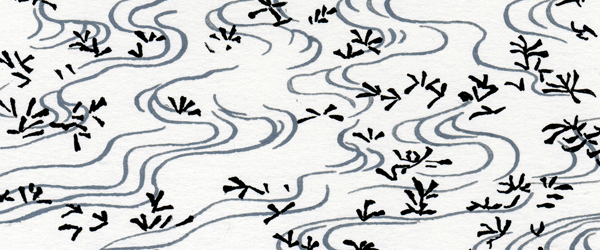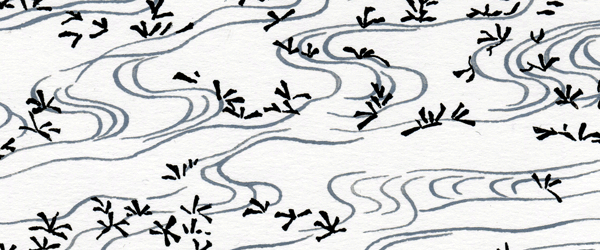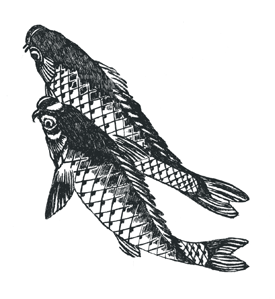‘Clearly I am thinking about nothing. I am most certainly looking at nothing. Since nothing is present to my consciousness to beguile me with its colour and movement, I have not become one with anything. Yet I am in motion: motion neither within the world or outside it – simply motion.’ Natsume Soseki, Kusamakura
I’m standing at the edge of a lido at 7:05am. This is the momentary pause when I spit into my goggles and brace myself for the exertion ahead. My mind rests for a moment, as it often does of late, on the word ‘action’. I’m really thinking of karma, but that word is, for me, too heavy with ideas of fate, preordination or determinism, which – though in line with the Hindu definition, wherein a personal supreme God plays a role in its delivery – is different from the Buddhist meaning I have come to learn. In Buddhism the word karma, translated literally as ‘action’ or ‘deed’, is simply a law of cause and effect, albeit one that works on a number of different scales – from instant karma to karmic rebirth. Though I have no belief in reincarnation, which excludes the greater of the scales from my purview, I’m finding this concept of volitional responsibility both a comfort and a drive. ‘Action’, I say to myself.
It’s a mildly chilly, grey summer’s day. As light rain steadily falls, I lower myself into the pool. This lido is, unusually, not laned-off for the early morning swim. Rather, swimmers space themselves along the 60-metre length to swim across the 18-metre width. Drops of rain gently burst the surface in an even patter, twinkling like stars above mesmerising ripples. A heated outdoor pool – this morning it’s 22ºC – doesn’t give the shock and rush of being immersed in the piercing cold of sea or river. I’m strangely disappointed, feeling faintly nostalgic for contracting muscles, pulsating limbs, blood rushing through head and toe – that marvellously fleeting part of swimming in the outdoors: the brusque awakening. Twenty seconds later, acclimated, goggles rinsed and in place, I’m off, mindfully propelling myself forward, timing my breathing with the action of my strokes.

I came to swim for much the same reason I came to practice meditation: to relax. To reconnect myself to a body that had become a stranger to me and free it from tension. For more than four years I had been struggling with, and endlessly distracted by, an increasingly draining dermatological condition. I shudder every time I hear the word eczema. Although my doctors have referred to it in equal measure as seborrhoeic dermatitis, which is not quite so bad (but still horrendous), there is something about that word, pregnant with memories of childhood affliction, that points to why skin conditions in adulthood seem to the sufferer, well… a little pathetic. In some respects eczema tells of a vulnerability – an inability to cope with certain external phenomena that is perfectly understandable in childhood, but which in adulthood suggests psychological or physiological shortcomings. In my case it was a cause of anxiety, insecurity and depression.
After years of managing my condition daily, an often stressful routine using a concoction of medicines in a futile effort to control the symptoms, I finally came across a doctor who suggested that stress was the most pressing issue to address. I began to think that my natural tendency to suppress stress – to divert it away from my consciousness – had made me ill. As I began to research relaxation therapies I came across Vipassana – a Buddhist meditation technique and ‘mindfulness’ practice – by chance when, stopping at a bookshop midway through a meandering walk, a friend picked up a copy of a Tim Parks book. Teach Us to Sit Still: A Sceptic’s Search for Health and Healing is an account of his journey through the neuroses of chronic illness, a story which ultimately found relief through the discovery and practice of Vipassana.
I soon booked myself onto a ten-day Vipassana retreat at a centre in rural Herefordshire taught (albeit remotely) by S. N. Goenka, an Indian lay teacher who had learned the technique from Sayagyi U Ba Khin in Burma. His method – non-sectarian in emphasis, but rooted in the Theravada school of Buddhism – is taught in centres around the world using audio tapes and evening video discourses, with assistant teachers overseeing the group sessions and answering questions on technique twice a day. At each group sitting, in the company of about 70 men and 70 women seated by gender on either side of the meditation hall, I was greeted by Goenka’s deep bass voice calmly issuing instructions in rich, resonant surround sound. It wasn’t quite the intimate experience I had expected having read Parks’ account of his retreat – taught in person by one of the American Vipassana gurus – but it was, nonetheless, a deeply affecting and transformative experience. Waking at four each morning to the sound of a gong, meditating for more than 10 hours a day, living in a commune of silent contemplation and concentration financed by the generosity of others, we lived the lives of Buddhist monks and nuns for the duration of our stay.
The first three days were spent practising anapanasati (literally, ‘awareness of breathing’). Concentrating our attention on the inflow and outflow of breath in and around the nasal passage we gradually narrowed the focus onto the sensation of breath on the upper lip as it enters and exits the nostrils. Going into the course I had been aware of the basic principles of this technique, but I hadn’t understood quite how difficult such a simple sounding task would be. Not only was my sensitivity to sensation dull to begin with, but keeping my attention trained on one object without being continually distracted by disparate fleeting thoughts was nearly impossible. Newly awakened to a distinction between thought and consciousness, I felt a little out of control. To concentrate on this sensation of breath without being distracted by thoughts that appeared to be autonomous entities, it seemed that I needed to be conscious but unthinking. The longer we practiced, however, the more alert and grounded I became, and the more I appreciated a depth of awareness and focus I had never before experienced. After 30 hours of slowly refining my sensitivity and strengthening my focus, I could concentrate for the full length of a session on a tiny area of skin below my nostrils, noting not only the strength and temperature of breath, but pulses, itches and subtle vibrations. We were now ready to move onto the main exercise – Vipassana. I was at first a little bemused to discover how hard it was to find the spot at the very top of my head, but once started I tentatively drew my attention, little by little, down my head, face, arms, torso and legs to my feet and toes before returning in the other direction, back to the top of my head. Over days of practicing, these ‘sweeps’ of the body became fluent, my awareness of sensation increasingly refined.
Our attention was regularly drawn to the transience of every sensation with reference to anicca, the Pali term for impermanence (one of the ‘three marks of existence’). Anicca, the unrelenting state of flux, the arising and passing of the phenomenal world, was, it seemed, an observable reality. Apart from the discomforts of the seated position, which wore off after a few days, no sensation seemed to last very long at all. Over the years I had become a compulsive and unthinking itcher, but on paying close attention to the itching sensations I had habitually scratched, none of them seemed to last more than a few seconds. ‘Annica… annica…’ Goenka would repeat. ‘Everything that arises passes away…’ The fleeting nature of sensory experience was framed for us within the context of an impermanent, unstable and highly contingent world, through which I came to a sense of self, less fixed and more fluid.

I’m on one of my quick lengths, torpedoing off from the turn before bursting through the surface into rhythmic action: my torso rotating with each long stretch, legs kicking as straight as I can manage, pulling myself forward with cupped arms, breathing with the outstretch of the left every four to eight strokes, feeling water both resist and give way, the rush of liquid and bubbles gliding over my entire body. There’s certainly a fluency, but I feel fully aware of everything I’m doing. It’s not like running or cycling, where I can switch off from the mechanics of the exercise – here in this pool I feel entirely present, vitally conscious of the subtle dynamic shifts of each changing stroke.
I have never jumped out of a plane or off the ledge of a bungee jump, but I think I understand the exhilaration of such weightlessness. Here in the pool, suspended in slightly chlorinated water, buoyed by its density, I feel free to glide along unbound by the pervasive grounding force of gravity. The aquatic realm is, as such, a respite from the seemingly fixed, inescapable material realities of the terrestrial world. As my alignment to the earth’s centre rotates by 90º, and upwards becomes onwards, my sense of place dissolves – focus shifting from where to what I am. Being immersed in water is like being placed in a bodily echo chamber – sensations and sounds reverberate through my consciousness. The cascades of bubbles following the strokes of my hands seem almost hyperreal. The sound of my beating heart so present, it could be coming from directly between my ears.

In the mediation hall the words awareness and equanimity were repeated endlessly. We were to be aware of sensation, but importantly we needed to observe these sensations calmly and objectively. The concept was a simple one – by observing bodily sensations with neutrality, one could train the mind to be less reactive. To simply be aware would carry on the natural tendency of reacting positively to pleasant sensations or negatively to unpleasant ones – developing or propagating cravings or aversions. This, we were told, is the root of all suffering. By learning to be aware with detachment we could reverse this trend, gradually weakening and then eliminating the tendencies of craving and aversion: agitating urges that dampen both awareness and appreciation of the present. By day ten the technique had been properly established. My body sweeps were as fluid as my sense of time and place. An hour’s sitting suddenly felt like twenty minutes. I experienced neither discomfort, tension, or pain.

I’m sitting cross-legged on a cushion at 6:05am, half way through my morning meditation. Clearly I am thinking about nothing. I keep my attention on scanning my body for sensations in a smooth but careful movement, registering subtle vibrations, pulses, currents, itches and strains. Occasionally thoughts do appear, hanging around for a moment before wandering off again. I train my attention back to the task in hand – to observe. In the calm still of silence I feel fully alive. An alarm signals the end of the hour. I quickly dress and excitedly prepare to cycle to the lido in the next town. After the 12km ride, paying the £3.50 entry, changing into my trunks and rinsing myself in the shower, I stand before the water’s edge, ready to begin.
To comment on an article in The Junket, please write to comment@thejunket.org; all comments will be considered for publication on the letters page of the subsequent issue.